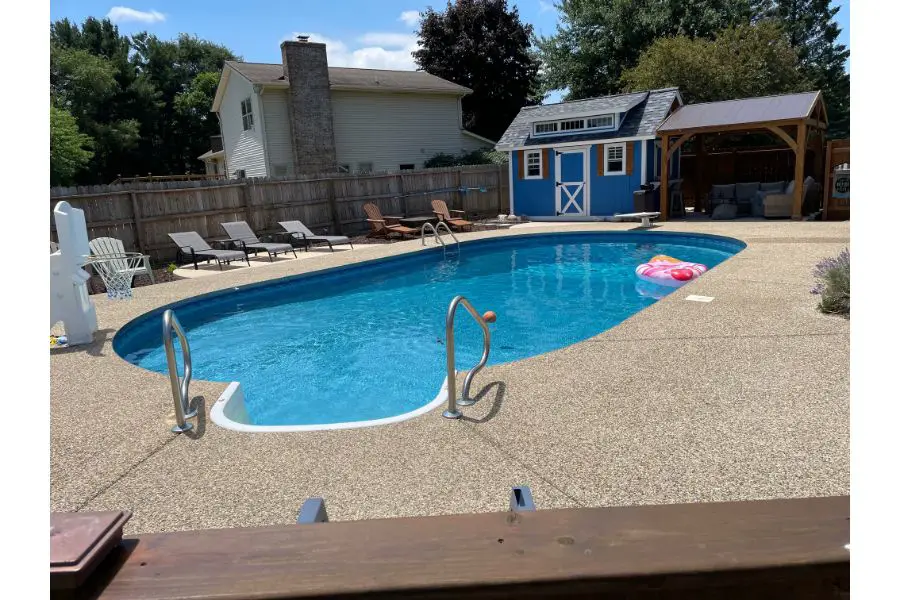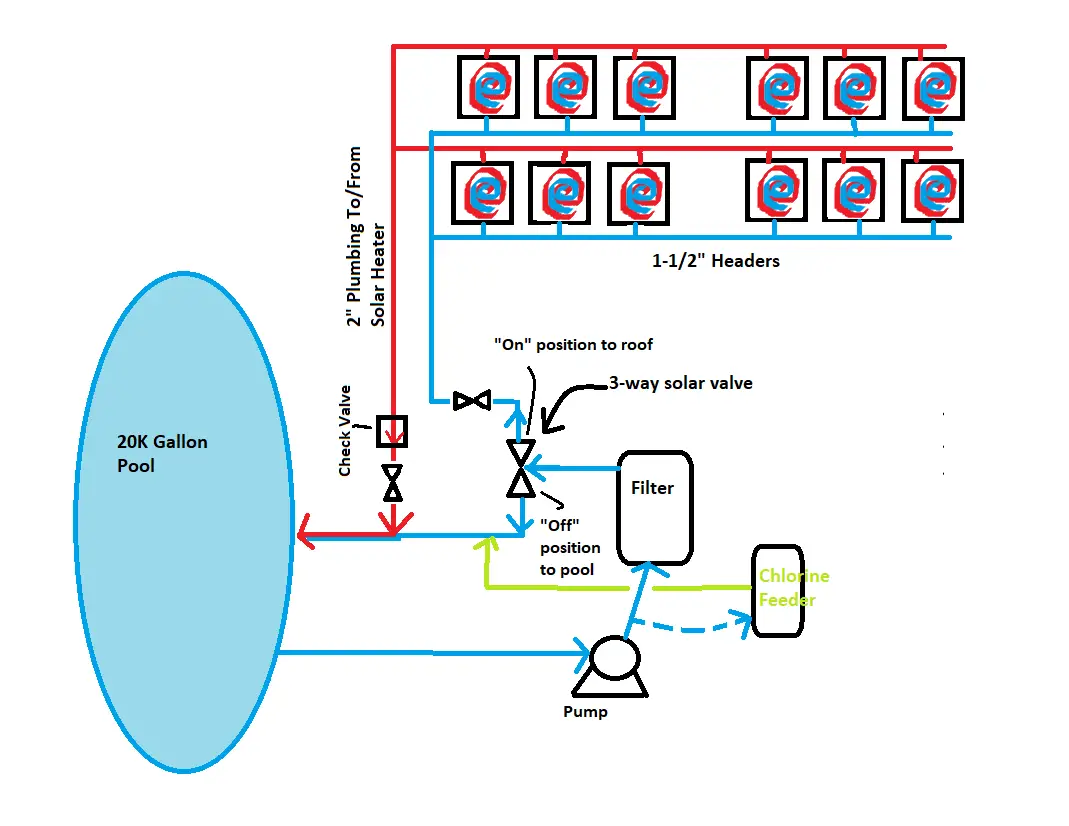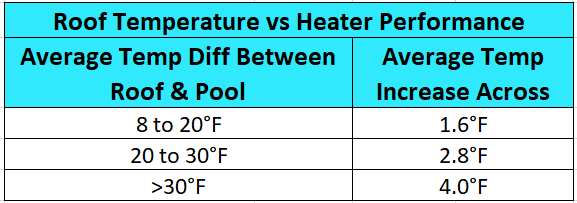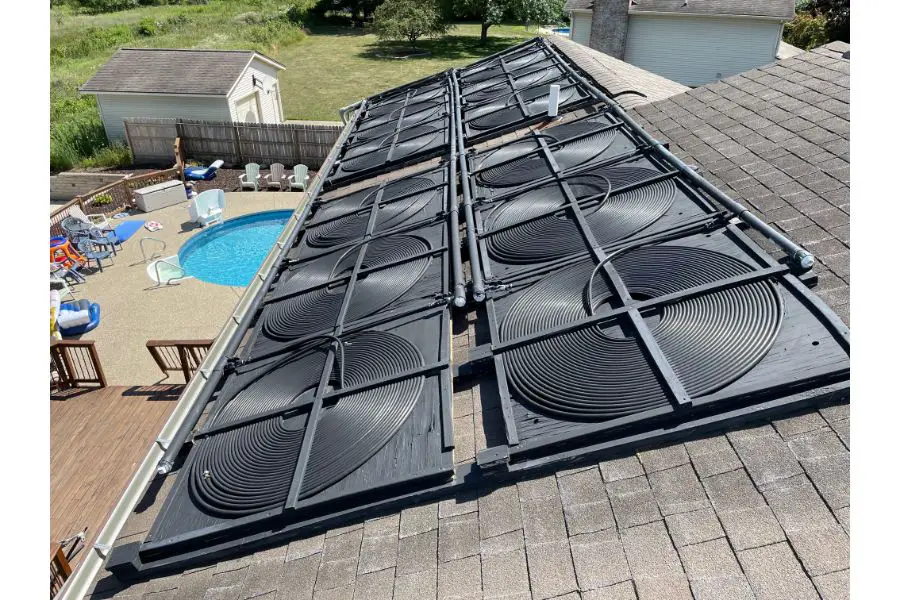Keeping the pool warm can be a challenge outside peak summer season, particularly in northern climates. Since most swimmers don’t enjoy dipping into a frigid pool, it’s important to find ways to keep the pool warm.
A pool heater is one way to heat the pool. While gas and electric heaters can quickly warm up the pool, they can also cause the utility bill to skyrocket.
Fortunately, a solar pool heater can be a great alternative in heating the pool. These heaters harness the sun’s free energy to heat up the pool water without having to pay extra utility costs.
There are several different types of solar panels that can be purchased, including tube manifolds, domes, and glazed collectors. It’s even possible to make a DIY solar pool heater.
While solar pool heaters do not have traditional operating costs, their initial investment can be somewhat pricey depending on the style and size purchased.
The cost of a solar pool heater can rightfully cause some hesitation as to whether it will be worth it, leading to the question: Do solar pool heaters work?
In this post we’ll look at whether solar pool heaters work, including some real data from our DIY solar pool heater that has been running for 8 years. We’ll also look at factors that can affect just how well a solar pool heater will work for your pool.
Let’s dive in!
Setting the Solar Pool Heater Up for Success
Before purchasing (or making) a solar heater for the pool, it’s important to review the lay of the land. This is a key step regardless of the type of pool solar heater in order to determine how well it will work for you.
Here’s a quick rundown of considerations to take when trying to achieve the best performance with a pool solar heater.
Proper Sizing

The industry recommendation is to install solar collectors that make up at least 50% of your pool’s surface area. This is often a good starting point in determining how many solar panels are needed to heat the pool.
For a standard 18 x 36′ oval shape pool, the approximate surface area is 600 square feet. So, at least 300 square feet of solar coverage is recommended.
The more surface area for the solar collector, the more potential for heat absorption. This means that trying to use a short black garden hose as a DIY solar heater may not provide enough area to actually work well for most pools.
Ground or Roof
When it comes to mounting the solar panels, the two most common locations are either roof-mounted or rack-mounted on the ground. Roofs often provide the largest and most unobstructed space for solar panels making it the more common location.
If mounting on the roof, you’ll want to assess the condition of the roof to ensure it still has plenty of life remaining. Otherwise, you may be uninstalling the solar panels before long in order to replace the roof.
For large properties without much natural shade, a rack-mounted solar heater on the ground may be a great choice. One benefit of a ground-mounted system is that it will be easier to access for any maintenance.
Whether installing on the roof or ground, you’ll need enough open space to accommodate the size of the solar panels. Going back to the 50% coverage target, this means a fairly large space may be needed for a mid-size pool.
Orientation
South-facing panels provide the best solar gains in the northern hemisphere. This orientation will be exposed to the largest amount of sunlight throughout the day, which will provide better solar panel efficiency.
But, don’t fret if you’re property is unable to accommodate south-facing panels. Pool solar panels can still work great when facing either east or west –it’s just that they may be up to 20% less efficient than due south.
Angle of the Panels
The pitch of the roof or the ground-mount can affect the efficiency of the solar panels. In general, an angle of less than 45° is recommended, but factoring in your latitude can better determine the ideal tilt.
Aiming for an angle that’s equal to your latitude minus 10º–15º will provide the best performance of the solar panels.
A minimum angle of 15° is recommended to allow for drainage of the system once solar heater turns off. For flat roofs, additional design considerations may be needed to support the solar heater.
Sun Exposure
Although obvious, it’s important that the solar panels receive direct sunlight in order to heat the water.
Any time shadows from nearby objects or clouds obstruct sunlight to the panels, the heating effectiveness will be reduced. This is often why roofs are commonly chosen for the solar panels as there are less objects casting shadows up there.
However, open fields without nearby trees or structures can provide a suitable location for panels.
Pump Flow
While temperature gain across the solar heater is very important, the flow rate through the heater is equally important. A high temperature gain with a low flow rate is generally not going to be as efficient as a lower temperature gain with a higher flow rate.
It’s important to strike a balance when determining the flow rate. If the flow rate is too low, the water may spend too much time in the solar panels, which can lead to excessive heat loss and reduced overall efficiency. Conversely, if the flow rate is too high, the water may not have enough time to absorb sufficient heat from the solar panels.
Solar panels will also inherently cause reduced flow rate due to the additional length of piping that the water needs to run through. Flow rate through the solar heater will depend on how far away your panels are from the pump, along with size and configuration of the panels.
If using your pool pump to circulate water through the solar panels, flow rate through the panels will need to be high enough to maintain adequate turnover rate of your pool. Pools should typically have at least one turnover of water each day.
If considering any type of solar heating for the pool, it’s recommended that you understand your pump’s capability. To go through the effort of installing a solar heater only to find that the pump cannot provide adequate flow would be disappointing.
It’s worth evaluating the current performance of your pump and estimating the Total Dynamic Head that will be added through solar heating. A pump performance curve can help understand whether it will be capable of providing adequate flow through the solar panels.
In some instances, a booster pump may be needed to achieve enough flow through the solar panels. While running a booster pump is still much cheaper than running a gas or electric heater, it will cut into some of the ‘free’ benefit of solar heating.
Do Solar Pool Heaters Work?
Solar pool heaters work great in most cases. Once the initial purchase has been made, the solar heater will provide free heating which beats having to pay costly utility bills for a traditional gas or electric heater.
Determining just how well solar pool heaters work is best determined by monitoring the pool temperature itself. While commercial pool heaters have specific ratings that can be used to calculate their theoretical output (BTU/hr), the real proof is going to be actually seeing and feeling the rise in water temperature.
Unlike traditional heaters that can quickly ramp up the water temperature, the solar heater will gradually warm the water. The solar pool heater may add 2 to 3°F per day to the pool, which can boost the temperature by upwards of 15°F in about a week.
As we previously reviewed, the performance of solar heaters is dependent on various factors, including collector sizing, exposure to sunlight, orientation, pump flow, etc. Solar heaters will be most efficient when the difference between roof temperature and water temperature is largest as this provides the greatest absorption of solar energy.
In order to get the most out of a solar heater, it’s important to use a solar blanket on cooler nights. This will help prevent heat loss that could quickly diminish the gradual daily temperature increase from the heater.
How Warm Does a Solar Heated Pool Get?
Determining how warm a solar heated pool can get will vary based on the heater output ratings, sizing, and environmental factors.
The solar pool heater should be configured to achieve the proper temperature rise per the manufacturer’s ratings. In many cases, the water temperature may increase by two to four degrees between the inlet and outlet of the heater. This means that a single turnover of the pool water through the solar heater could increase the pool temperature by several degrees, assuming no additional heat loss to the surrounding environment.
In general, a properly sized solar heater should be able to elevate the temperature of the water 10 to 15°F above the ambient outdoor temperature over the course of several days. So, even during the early parts of the pool season when temperatures may only be reaching the mid-70s, it’s still possible for the water temperature to remain at a comfortable mid-80s.
Personal Experience with DIY Pool Solar Heater

While a homemade solar heater is typically less efficient than commercially produced heaters, our DIY solar heater has been able to produce great results over the 8 years we’ve had it. We live in a northern climate and are able to keep the pool a comfortable 85 to 90°F throughout much of the swim season.
If we’re in the water swimming while the solar heater is on, we can feel a strong current of warmer water flowing back into the pool through the jets. The kids have been spoiled with the heater, as temperatures under 85°F often illicit some complaints of the water being cold.
The DIY solar heater has allowed us to extend the pool season on both the front and back ends when many neighboring pools are closed down for the season. However, the sun is not as high in the sky during early May and October, so the heater results are pared back compared to peak summer.
During a three-month study consisting of dozens of measurements through the morning, afternoon and evenings, we found that our solar heater provided an average rise of 2.6°F between the inlet and outlet with a flowrate of 32 gallons per minute. We saw as much as a 5°F rise across it during the peak summer sun.
During the study, the average pool temperature was 85°F while the average outdoor air temperature was 78°F; however, the average roof temperature where our panels are located was 101°F. We saw the highest solar gains from 11AM to 3PM, when the sun was more directly over the panels and the roof temperature reached up to 120°F!
Unsurprisingly, our DIY solar heater is most effective when the difference between roof temperature and water temperature was largest. Here’s a simple summary of our heater’s performance across varying roof temperatures:

Commercial solar panel manufacturers often market the ability to achieve a 10 to 15°F heat gain over the course of a week or two. While we don’t have the ability to directly measure the BTU output of our homemade heater against a commercial one, our data indicates the ability to achieve similar temperature gain.
How Fast Can a Solar Heater Heat Pool Water?
The pace at which a solar heater can heat the pool will depend on the flow rate through the heater along with the temperature rise across it. Based on the data collected from our homemade solar heater, we were able to determine how quickly it can heat up the water.
We know that our average temperature increase across the heater is 2.6°F and our typical flow rate is 32 gpm. This equates to 41,000 BTU/hr from the solar heater.
Since it takes one BTU to heat up one pound of water by one degree Fahrenheit, we can determine how long our solar heater will take to raise our pool temperature by one degree:
- Our pool is 20,000 gallons. A gallon of water weighs about 8.3 lbs. This calculates to an overall weight of 166,000 lbs.
- Time it takes to heat the pool 1°F = 166,000 lbs divided by 41,000 BTU/hr = about 4 hours.
With our heater typically running about 8 hours each day, this means it is adding 2°F every 8 hours of runtime. It’s not uncommon to see our pool rise by 6°F or more in a day after also factoring in natural heat gain from the air temperature or sunlight directly onto the pool.
For store-bought solar heaters, the output rating (BTU/hr) can be used in similar manner to calculate how fast it will heat the pool water. In many instances, solar heaters are only 50% efficient, which must also be factored in when estimating how quickly it will heat the water.
Although a 2 or 3°F daily increase of pool temperature from the heater may not sound impressive, over the course of a week it has the potential to add close to 15°F compared to an unheated pool. This is particularly true if you protect your heat gains by using a solar cover on cooler nights.
Just know that while solar heaters are great in providing free heating to your pool, they will not heat anywhere near as quickly as a traditional gas or electric heater. Traditional heaters can raise the pool temperature by about 20°F in 24-hours.
Final Takeaway
It’s been proven that pool solar heaters work well under the right conditions. Just don’t expect them to heat as quickly as a traditional gas or electric heater.
Before making the investment on a solar heater, it’s important to understand the various factors that can affect its performance. These factors include sizing, location, orientation, angle, and flow rate –all of which work together to transfer the sun’s energy into the water.
It’s also important to understand limitations of even the most efficient solar heaters, as they are designed to gradually heat the water. After several days of runtime though, it’s possible for the solar heater to increase the pool temperature up to 15°F higher than the ambient temperature.
To retain the precious heat provided by the solar heater, it’s essential to use a solar cover on those cool nights. This will help keep the pool temperature comfortable throughout the swim season.
Ultimately, if you have patience in heating your pool, a solar heater is a great option that will pay for itself quickly!
Happy (warm) Swimming!
Husband and father of three (actually, four if you include the pool). I’m an avid DIY-er and weekend warrior that enjoys taking up new projects around the house to help us maximize leisure right at home. I enjoy researching and sharing various tips, tricks and knowledge to help others make their home an oasis.

